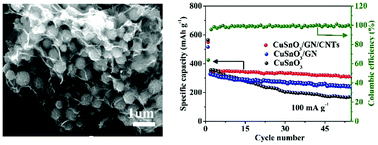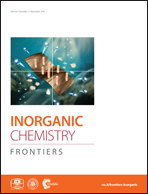Amorphous CuSnO3 nanospheres anchored on interconnected carbon networks for use as novel anode materials for high-performance sodium ion batteries†
Abstract
Traditional tin (Sn)-based oxide materials suffer from huge volume expansion/contraction during discharge/charge cycling, resulting in poor cyclic stability when they are used as anode materials. In comparison, the bimetal Sn-based oxides have gained increasing attention in the field of rechargeable sodium ion batteries (SIBs) because of the synergism between the metal components, which prevents agglomeration of the active particles. In this work, the electrochemical performances of copper tin oxide (CuSnO3) as an anode material for SIBs were investigated for the first time. The amorphous CuSnO3 nanospheres anchored on interconnected carbon networks were easily prepared by mixing copper tin hydroxide [CuSn(OH)6] with graphene oxide and carbon nanotubes to form a composite, followed by a freeze-drying treatment and calcination. The intrinsic structure and carbon networks of the composite effectively buffer the enormous volume variation and enhance the conductivity of the active particles during discharge/charge cycles, contributing to the good cycling stability (310.8 mA h g−1 at 100 mA g−1 after 55 cycles). This work also reveals the enhancement in conductivity caused by the metallic copper generated during cycling and the effect of carbon networks, proving the bimetal oxides to be promising anode materials for SIBS.

- This article is part of the themed collection: Inorganic Chemistry Frontiers HOT articles for 2018


 Please wait while we load your content...
Please wait while we load your content...